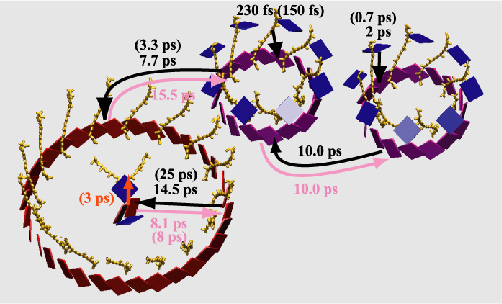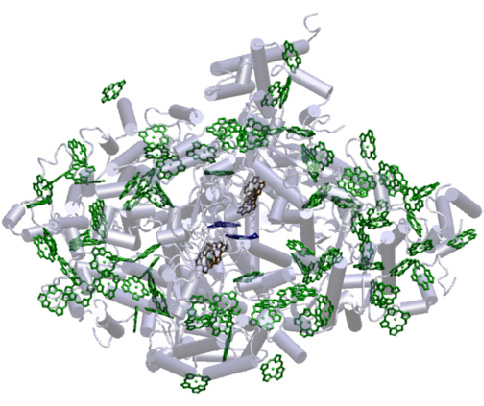| Overview
Most of the energy consumed by living species on earth stems directly
or indirectly from the sunlight harvested by photosynthetic cells. The
light harvesting apparatus works like a solar cell, and optimizing its
efficiency for the various habitats of life forms was a key design principle
of the apparatus. After exploring for decades the role of individual molecules
in light harvesting, chlorophylls, carotenoids, and small aggregates of
these, we can now put their findings together to calculate the overall
efficiency and operational characteristics of a particular light harvesting
system, that of purple bacteria.

Based on structural biology, spectroscopy, and quantum mechanical calculations,
the kinetic scheme shown in the below figure was devised to show how the
energy gained by the system through the absorption of a photon is transferred
on towards the photosynthetic reaction center. In the reaction center,
the energy is used to generate a membrane potential, which provides the
energy for further metabolic processes.
The kinetic scheme represents a remarkable conceptual achievement in
that it shows that excitation transfer times can be calculated almost quantitatively
through application of quantum mechanics to known atomic geometries.
Details of the research program leading behind this result can be found
in my earlier quantum
biology webpages at the Theoretical Biophysics Group at UIUC. A streaming
video movie gives a 5 min introduction to the atomic level structure and
function of the photosynthetic unit of purple bacteria.
Designing optimal light harvesting systems
The ability to calculate energy transfer times from atomic structures
with high accuracy opens the avenue to study how structural changes affect
energy transfer times and, hence, the efficiency of the light harvesting
system. Ultimately, we would like to answer the question: how can one arrange
a given number of pigments with certain absorption properties in such a
way that they funnel light towards the reaction center with minimal loss
or that they provide the greatest protection from photoreactive damage
through excess light? We can gain insights to this question by learning
from nature and looking  at
the strategies employed in different photosynthetic systems. After studying
the photosynthetic system of purple bacteria, we investigated the photosystem
I of the cyanobacterium S. elongatus, whose structure (shown in the figure
left) was recently resolved in atomic resolution. In contrast to the highly
modular and symmetric structures of purple bacteria, the geometric arrangements
of chlorophylls in photosystem I appears to be rather random. However,
a more detailed analysis of the apparatus shows that this system has been
designed with a high degree of fault tolerance and optimality: pruning
single and even multiple chlorophylls hardly affects the efficiency of
the apparatus; altering the chlorophylls' arrangement though leads to a
reduction of efficiency. Acknowledging that the chlorophyll arrangement
is highly optimal is only a first step. We now need to understand what
structural features underlie this high optimality, so that we can transfer
the lessons learned from nature to design artificial systems with high
optimality. at
the strategies employed in different photosynthetic systems. After studying
the photosynthetic system of purple bacteria, we investigated the photosystem
I of the cyanobacterium S. elongatus, whose structure (shown in the figure
left) was recently resolved in atomic resolution. In contrast to the highly
modular and symmetric structures of purple bacteria, the geometric arrangements
of chlorophylls in photosystem I appears to be rather random. However,
a more detailed analysis of the apparatus shows that this system has been
designed with a high degree of fault tolerance and optimality: pruning
single and even multiple chlorophylls hardly affects the efficiency of
the apparatus; altering the chlorophylls' arrangement though leads to a
reduction of efficiency. Acknowledging that the chlorophyll arrangement
is highly optimal is only a first step. We now need to understand what
structural features underlie this high optimality, so that we can transfer
the lessons learned from nature to design artificial systems with high
optimality.
|